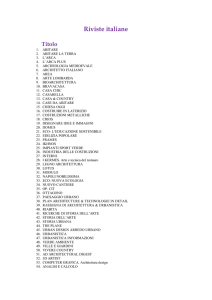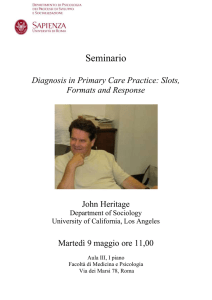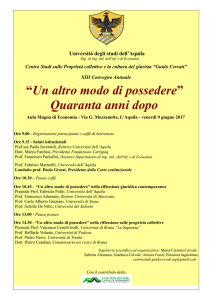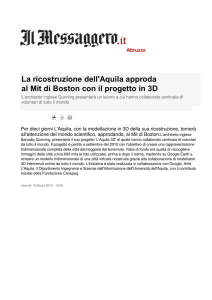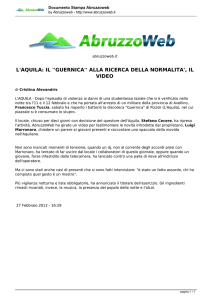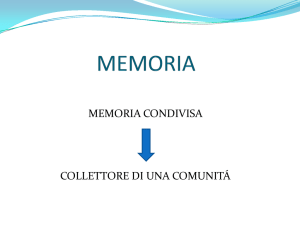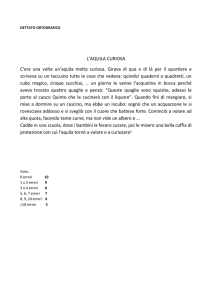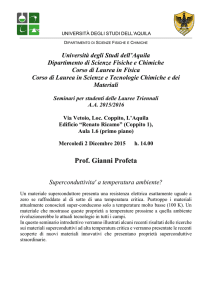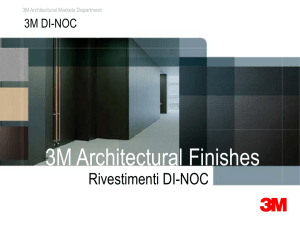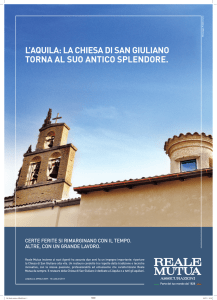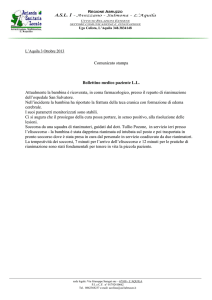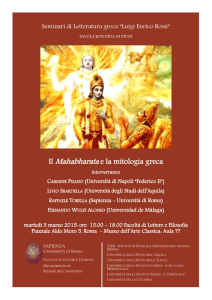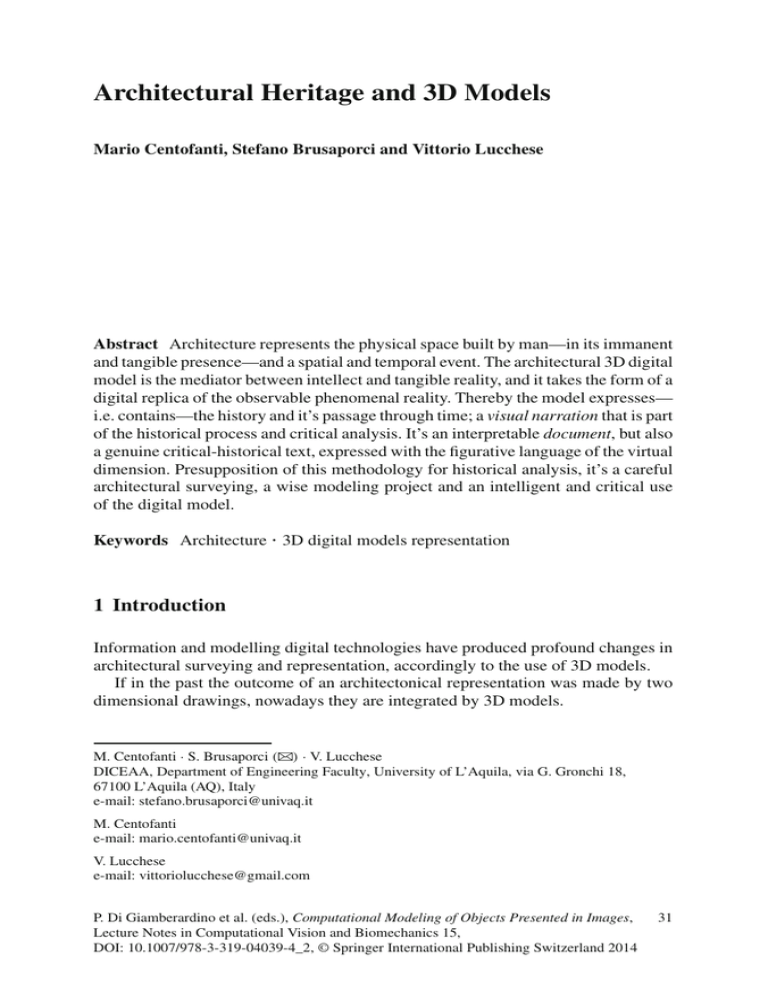
Architectural Heritage and 3D Models
Mario Centofanti, Stefano Brusaporci and Vittorio Lucchese
Abstract Architecture represents the physical space built by man—in its immanent
and tangible presence—and a spatial and temporal event. The architectural 3D digital
model is the mediator between intellect and tangible reality, and it takes the form of a
digital replica of the observable phenomenal reality. Thereby the model expresses—
i.e. contains—the history and it’s passage through time; a visual narration that is part
of the historical process and critical analysis. It’s an interpretable document, but also
a genuine critical-historical text, expressed with the figurative language of the virtual
dimension. Presupposition of this methodology for historical analysis, it’s a careful
architectural surveying, a wise modeling project and an intelligent and critical use
of the digital model.
Keywords Architecture · 3D digital models representation
1 Introduction
Information and modelling digital technologies have produced profound changes in
architectural surveying and representation, accordingly to the use of 3D models.
If in the past the outcome of an architectonical representation was made by two
dimensional drawings, nowadays they are integrated by 3D models.
M. Centofanti · S. Brusaporci (B) · V. Lucchese
DICEAA, Department of Engineering Faculty, University of L’Aquila, via G. Gronchi 18,
67100 L’Aquila (AQ), Italy
e-mail: [email protected]
M. Centofanti
e-mail: [email protected]
V. Lucchese
e-mail: [email protected]
P. Di Giamberardino et al. (eds.), Computational Modeling of Objects Presented in Images,
Lecture Notes in Computational Vision and Biomechanics 15,
DOI: 10.1007/978-3-319-04039-4_2, © Springer International Publishing Switzerland 2014
31
32
M. Centofanti et al.
Architectonical heritage’s 3D modelling is conceptually related to knowledge:
it’s required the values understanding and their appropriate documentation and representation. Digital models are architectural medium, in this way meta-models that
describe the buildings, namely a complex system made by spaces, surfaces, materials, constructive technologies and degradation, with modification and stratification
processes witnesses of events and cultures that have occurred over time. Therefore
this kind of models are the antithesis of that digital non-places offered by video
games’ platforms, because they have to be representative of architectural individuals, with own characteristics, result of historical defined events, belonging to a precise
context.
The chapter is divided into four sections: the second one is about the nature of
the model for the historical architecture (Mario Centofanti); the third one illustrates
an analysis’ method, developed in the Italian experience, based on the use of interpretative models (Stefano Brusaporci); the fourth one is about a specific case study
(Vittorio Lucchese).1
2 The Role of the 3D Model in the Cognitive/Planning
Process of Historical Architecture
The final product of an architectural survey is the representative model.
The meaning and essence of the changes in architectural models, in the transition
from traditional surveying to surveying using 3D optical measuring techniques, above
all with reference to the reciprocal interactions between subject, phenomenal reality
and model, have all been amply explored.
Models can be generated by CAD software using manual modelling, or directly
generated by automatic scanning, be static or dynamic, be manipulable and interactive, and demand the creation of suitable standards.
The model, in its role as mediator between the intellect and tangible reality, is the
tool people use to organize their mental representations of perceptible, phenomenal
reality. In the contemporary period this takes the form of a digital replica, with its own
autonomy, and a level of verisimilitude and immersive potential that raises doubts
over its being an integral substitute for reality within the cognitive process. Yet it
is not possible to overcome the otherness between the model and the phenomenal
manifestation of the real object; in a hermeneutic key, in the sense of an isomorphic
relationship, intended not as identity but analogy [64, p. 491].
The model, in its role as a medium between the subject and the phenomenon, represents by its very nature a modification of the latter. This mutation is connected to the
transit through the human mind and the patterns that significantly involve the subjective perception of the observer, and also to the reduction of the object/phenomenon
represented to an entity which is in any case discretized, irrespective of the pro1
The models of modern buildings presented in the paper are made by Stefano Brusaporci and
Vittorio Lucchese.
Architectural Heritage and 3D Models
33
grammed precision and definition. From a perceptive point of view, about the digital
reproduction of the architectural reality, we recall the concepts expressed by Walter
Benjamin in his classic “The Work of Art in the Age of Mechanical Reproduction”
(1936):
the architecture as prototype of a work’s collective use through a distracted perception, that
is fragmented, jerky; the substitution of the cultural value with the expositive value.
The study of architectural history focuses on the physical space constructed by
man, its immanent, tangible presence and its dimension as event, as spatial and
temporal happening.
The cognitive act is the experiential act. But it is the lived experience of the event
as a sequence of spatial/temporal events, up to the event in the present that sums up
all the previous ones. The model thus expresses — in the sense that it contains —
the history and the passage of time of the situation explored from its conception, to
its creation, to its transformations, up to the current period: historic/synchronic and
diachronic sections, reconstructions and/or visualizations of modified situations, or
intentions and prefigurations never actually implemented, or simply narrated.
If we refer to Paul Ricoeur’s reflections on the narrative dimension of architecture
and the temporal dimension of architectural space [58], we can reconsider the model
itself as a visual account of an architectural narration.
The structured, complex model, as explained thus far, figures in the process of
historical/critical analysis as a ‘document’ therefore itself open to interpretation, but
also a genuine historical/critical text expressed with the language of figuration in the
virtual dimension.2
The premise of a restoration project is the necessary relationship with something
pre-existing. Surveys and models therefore play a strategic role as a cognitive act—
Brandi’s notion of recognition—and as a fundamental instrumental support, with
regards to the specular relationship we expect between a descriptive/interpretative
model and a planning model.
From the theoretical/methodological point of view we can draw parallels with
the procedure of Reverse Modelling, in which a digital survey of surfaces and the
construction of the relative digital model using polygonal or polynomial modelling
represent a starting point for designing industrial products [44].
The specific nature of the architectural model however demands that we go beyond
what is visible, exploring the intimate make-up of an architectural organism, namely
its structural elements. The concept of duality that Brandi [9, p. 10] expressed with
regards to works of art:
matter as the revelation of the image manifests the bipolar rapport between matter as appearance and matter as structure
also applies to historic architecture, where the matter/structure itself forms the
architectural space. In this regard mention has been made of the notion of an anatom2 “ [...] a serious graphic apparatus is first and foremost a record and at the same time a genuine
historical/critical ‘text’, not expressed in the usual verbal language, but in the language of figuration.”
[18, p. 472]. Also see [17, 19, 40].
34
M. Centofanti et al.
ical survey, which implies the creation of a descriptive model including structural
components and elements [23–25]. The latter must be explored and identified by
means of the usual operations of documental analysis and non-destructive diagnosis
as a precautionary measure, and then by monitoring while work in is progress.
Models of this kind integrate our interpretation of geometrical and dimensional
data and formal, figurative, architectural and spatial values, providing an analysis
of the material and structural characteristics. To quote Vitruvius, this kind of model
provides the correct premise for restoration projects that should succeed in combining the necessary firmitas, or solidity (reducing seismic vulnerability) with venustas,
beauty (spatial and figurative restoration), and utilitas, usefulness—in terms of restoring function or repurposing. In the process of critical restoration the model fulfils
various tasks when it comes to monitoring work in progress and any modifications
to ongoing work; in terms of comparing the transformations wrought by the restoration work to the previous state of the building, and in the ongoing monitoring of the
building after the restoration work for the purposes of planned maintenance.
3 From the “Graphical Analysis” to 3D Models
for Architectural Analysis: The Italian Experience
In 1989 Mario Docci published a paper titled “Disegno e rilievo: quale didattica?”
[Drawing and surveying: what didactics?], in the first issue of the journal “Disegnare Idee Immagini—Drawing Ideas Images”3 [31], concerning a methodology for
architecture analyzing, tested by the author and his staff in the Course of Design
and Surveying held at the Faculty of Architecture of the University of Rome “La
Sapienza” from the academic year 1975–1976. The chapter recalls what he has
already published in 1983 in the book “Disegno e analisi architettonica” [Drawing
and architectural analysis] [33].
Aim of the chapter is presenting how drawing, in addition to be suitable for project
communication, can be an instrument to study building’s characteristics. Referring to
the structuralism lesson, drawing is regarded as a meta-language, that is a graphical
language able to analyze another language, the architecture’s one.4
Although in the didactic field, it’s developed a research method for critical analysis, believing that going thought the projects of great masters—modern and of the
past—with drawing is a useful way to understand the architectural values.
3 The journal “Disegnare Idee Immagini—Drawing Ideas Images” is edited by the Department
of Representation and Surveying (now Department of History Drawing and Restoration of Architecture) of Rome University “Sapienza”, published in Rome by Gangemi, indexed by Thomson
Institute for Scientific Information (AHCI Arts and Humanities Citation Index) ISSN 1123-9247.
Over the years the journal has been a constant reference for those who studies architectural analysis
and representation, publishing many of the most relevant Italian assays. Except for the cited paper
published in 1989, all the others issues that will be quoted from this journal are in full English text;
in references there are the original Italian titles.
4 In general for a semiology approach to architecture:[8, 34].
Architectural Heritage and 3D Models
35
In particular Docci quotes the expression “graphical analysis” from the book
“Analisi grafica dei valori architettonici” [Graphical analysis of architectonical values] of the mid-fifties (then 1960) by Vincenzo Fasolo, professor of History and
Styles of Architecture since 1925; he also widely uses the instrument of drawing for
reading, analyzing and comparing historic buildings in his essay “Guida metodica
per lo studio della storia dell’architettura” [Methodological guidebook for studying
the history of architecture] [36].
In the graphical analysis Docci identifies a methodology based on rigorous criteria, that allows to study proportions, volumes, forms, configurations and structures,
and the relationship between all the elements that contribute to the conformation of
the architectural language. In particular Docci focuses on the usefulness of schematizations, seen as a real interpretative models of architectural language [31, pp. 38–39]:
The graphic medium is used to create models for architecture, or urban space, understanding,
to get a sense and analyse it as a scientist artificially reproduces a phenomenon in his laboratory. In this way drawing identifies with the model’s concept, or better with a knowledge’s
graphical model. In this regard it should be noted that a model is really a model when it is
composed of set of elements linked together by the same rules which govern the elements
constituting the space, described by the model; therefore it couldn’t represent the building
as it appears, but it establishes an analogy to point out the laws that regulate the organization
of the work. Then it’s a process of reduction of the complex architectural reality, to exalt the
significant characteristics, highlighting them in a schema.
On an operational level we have to do different analysis, but aware that they represent specific thematizations, and there should be a final re-composition of the results.
In particular Docci suggests to conduct distributive, formal, spatial and structural
analysis, of the relation between the building and its context, associated to synchronically and diachronically studies between it and others of the same architect and of
other authors.
By surveying and representation digital technologies’ developing, there have been
many applications related to historic buildings, especially aimed at its communication, enhancement, enjoyment and management. The debate on the relationship
between new technologies and representation of architecture was, and still it is,
wide-ranging [63, 65–67].
If at the beginning the studies involved on unavoidable problems of computer
graphics—we remember the example of the model of the abbey of Cluny, made by
IBM France in 1992—, through the years the technological progress of 3D modeling and rendering, especially real time rendering, has favored the development
of virtual reality, in particular of virtual heritage that combines Information and
Communication Technologies with the field of architectural heritage; moreover the
technologies of augmented reality contribute to implement immersive, dynamic and
interactive experiences [45]. Virtual reality allows the interacting simulation and
real-time processing of all the information that is contained in the model; this aspect
promotes the development and diffusion of virtual museums [59].
At the same time the graphical analysis methodology has found a way of developing in 3D modeling technologies, producing a field of study where the digital
model acquires the function of “meta-model”, that is an instrument for architecture’s
36
M. Centofanti et al.
critical5 —and in particular historical-critical—analysis. Compared to traditional
graphical analysis, made by two-dimensional drawing such as plants, elevations,
sections, perspective and axonometric projections, 3D models allow a continuous
multi-dimensional and multi-level interpretations, favoring visualizations and synthetically simulations.
Modelling and semantics problems—not more and not just issues of computer
graphics—are related to the architectonic ones, so the digital model’s characteristics
are inseparably linked to the ones of architecture (for example if it’s a ruin of classical
age, a renaissance palace, a baroque church, a modern building) and to the ones
of the specific and individual building under study. From this point of view the
process of model’s construction is particularly important, as critical synthesis and
integration of architectural survey and analysis of historical documents; of particular
importance it is the study of the transformation phases, of the relationships with
the context, of the constructive elements. Moreover such models can be used as
core aggregator and organizer of documental information, that is as framework for
architectural information systems [10].
In the Italian experience numerous researches can be attribute to the area of 3D
modelling for architectural analysis. According to a first classification, it’s possible
to distinguish between studies on historical architectures and studies on modern
buildings, for which especially may be available original project; these graphical
documents require a careful study, both from an historical point of view than in
relation to the building.
A second classification can be made between studies on existing buildings and
not more existing ones (or profoundly transformed). In the second case it is required
the virtual reconstruction of missing conformations, philologically reconstructed. To
this field can be attributed many of the experiences on surveying and virtual reconstruction of archaeological sites; among all we remember the researches coordinated
by Francesca Fatta on the archaeological sites in Northern Africa and in Southern
Italy: models are built referring to a systematic study of archaeological maps, essays
on architectural and archaeological history, drawings made for excavations since the
eighteenth century, artefacts in museums [37].
On 3D models for historical critical analysis, it’s significant the experience coordinated by Mario Docci regarding the digital reconstruction of the Sangallo’s project
for the St. Peter’s Basilica, based on the drawings made for Pope Paul III in 1537–
1538 and on the reverse modeling of the original wooden model in 1:30 scale. Known
are the criticisms advanced by Michelangelo about low lighting, excessive decorations and too many orders of columns; on the whole, he said that the project wasn’t
conforming to classical language. The digital model allows us to verify the values
of the Sangallo’s project, to study the shape of the dome, to increase proportional
analysis and, last but not least, to understand the author’s concept [7, 32].
5
The “historical-critical method” refers to a set of criteria for the historical and philological study of
the architectural heritage; the building it’s intended as a synthesis of modification and transformation
that conduced it to the current configuration, results of architectural cultures and interventions that
have taken place over time [15].
Architectural Heritage and 3D Models
37
Not different experience it’s the one proposed by Marco Carpiceci, who presents
the 3D digital reconstruction of architectures drawn by Leonardo da Vinci, considered
emblematic of his thought. The study was conducted according to a philological and
hermeneutic point of view, which aims to reveal Leonardo’s ideas [21].
The research unit guided by Marco Gaiani presents an hypothesis of attribution
to Palladio of a drawing regarding Villa Contarini a Piazzola sul Brenta (secc. XVI–
XVII–XIX). Being available limited drawings, the study develops issues of model’s
semantization in order to built the whole model of the planned building [2].
In the chapter on the Palazzo Mattei di Giove in Rome (XVI–XVII), Livio Sacchi
uses the digital model to study geometrical, proportional and constructive building’s
rules [61].
Mario Centofanti applies the method of 3D modeling to the study of architectural
heritage, using the analysis and views made by the digital model to explore the
architectural characteristics of the building of Margaret of Austria in L’Aquila (XVI–
XIX centuries) [25].
On the virtual reconstruction of no more existing configurations of historical
buildings, we cite the work of Stefano Brusaporci about the churches of St. Justin
and St. Paul near L’Aquila (XIII–XVIII–XX centuries), churches that in 1946 have
been subjected to restorations. In particular the first one was reconfigured it in a
medieval way. Brusaporci virtually re-built the church as it was before according
to architectural survey and archival data; the historical photographic documentation
of 1946 made it possible—through techniques of digital photogrammetry, used in
analogy to what happens in forensics and accident fields—to define the architectural
elements now missing ([14]), (Figs. 1 and 2).
Important contributions are related to the modern architecture. The publication
of 2001 titled Architettura Disegno Modello [Architecture Drawing Model], editors
Piero Albisinni and Laura De Carlo, proposes an experience based on the use of
3D models for the graphical analysis of the works of Giovanni Michelucci, Maurizio Sacripanti and Leonardo Savioli. The study, that starts from original drawings,
favours the analysis of these authors and of their works in relation to their historical context. 3D models, sectioned and/or exploded, with the analysis of selected
components, promote critical representations [1].
Livio Sacchi, aiming to a close examination of the theories underlying compositional choices, presents the virtual reconstruction of some unrealized buildings—the
buildings represented in Studi per la Città Nuova by Antonio Sant’Elia (1913–1914)
and the Danteum by Giuseppe Terragni (1938)—as well as of a series of architectures
built in the modern age, in particular the ones of the EUR district (1935–1936) in
Rome [66].
Among the studies on the use of models guided by Riccardo Migliari, we remember those who have, as case studies, the Maison Citrohan of Le Corbusier and the
Danteum of Giuseppe Terragni. In particular, with regard to the second one we
observe the particular attention placed in setting the project, not realized, in the
historical context of the city of Rome [52].
The theme of modern movement studying through digital modelling, in order to
investigate and experience buildings no longer existing, it’s presented by Francesco
38
M. Centofanti et al.
Fig. 1 Digital model of S. Justin’s church. It allows to represent building’s architectural characteristics
Maggio and Marcella Villa with the digital reconstruction of houses realized for the V
Triennale of Milan in 1933, and then demolished [47]. Francesco Maggio also deals
with the study of two existing buildings in Agrigento: the Balilla’s House by Enrico
del Debbio (1929) and the Post Office building by Angiolo Mazzoni (1931–1939)
[46].
And similarly Stefano Brusaporci uses 3D models in his essay on modern Italian
architecture [14] (Figs. 3, 4, 5, 6 and 7).
Rodolfo Maria Strollo, in a study on the complex of the observatory of Tusculum
(1939), not only presents the surveying model, but uses models—derived from original drawings—to compare different planning solutions, in order to analyze for each
one the figurative and material values, and at the same time to reconstruct the events
that led to the final design configuration [63].
The condition of the digital model to be freely represented, interrogated and
browsed, in time and space, according to broader media, semiotic and epistemological schemes, compared to traditional 2D drawings, favours the study and the
Architectural Heritage and 3D Models
39
Fig. 2 3D photorealistic model of the church of S. Paul near L’Aquila (XIII–XVIII–XX centuries)
Fig. 3 Casa del Balilla in Ascoli Piceno (1933–1934). Rendering with the perspective section of
the tower and office block
communication of architectonical heritage’s values and characteristics. With a risk
of aestheticization own sake [48]—a “Dionysian tension” of “absolute appear” in
the words of Purini [56, p. 95] )—but with new and relevant scientific virtue.
Obviously the case studies cited are not exhaustive; they want to represent the contents of a line of research that can benefit greatly from the development of information
technology but which has the presupposition of its methodological application in a
40
M. Centofanti et al.
Fig. 4 Casa del Balilla in Ascoli Piceno Isometric rendering and perspective section of the cinema.
You can see the office block with a tower, the hall of the gym, cinema
Fig. 5 Casa del Balilla in Ascoli Piceno. Render isometric split from the bottom. Although internally the buildings are connected, each has its own entrance on different elevations
depth historical analysis, in a careful architectural survey, in a wise modeling project
and in an intelligent and critical use of the digital model.
4 Case Study: The “Cinema Massimo” in L’Aquila
The “Cinema Massimo” in L’Aquila, commissioned by the Istituto Nazionale
Fascista Assicurazione contro gli Infortuni sul Lavoro, was planned by the roman
architect Luigi Ciarlini between 1940 and 1941 and built between 1943 and 1947
[14]. The project is part of the renovation of the historical cities and belongs to that
process of social buildings development, promoted by the Fascist government. In
this period were built many constructions for directional activities and social services
Architectural Heritage and 3D Models
41
Fig. 6 Opera Nazionale Dopolavoro in Chieti (1933–1934). Rendering of the principal front,
characterized by two helical stairs to reach the roof garden
such as schools, hospitals, government agencies offices, case del Fascio, buildings
for workers’ club, etc. There are “new” building typologies and among them a particular importance was given to the cinema for cultural purposes and propaganda.
The renovation of L’Aquila historical city had already begun in the second half of
the nineteenth century [22], focusing on the widening of Corso Federico II, the main
axis of the urban plan, with the purpose, never fully completed, to build continuous
porticos along the main street’s sides.
The typological-distributive system of the Cinema Massimo follows from the
requirements of context insertion, with the integration of the external space of the
portico with the building project (Fig. 8). From the porticos, characterized by columns
with entasis, you can enter in the foyer which is placed beside to the hall and interior
service spaces. On the other side, the hall overlooks directly the outside through
safety exits. From a constructive and formal point of view, the building is fully into
the architectural and historical context of the ’30s and ’40s in Italy, when it began
the structures building with reinforced concrete, but without the figurative value
present in the European avant-garde. In fact, the Italian architecture keeps a close
relationship with the formal solutions previous to the introduction of frame-systems
with the presence of walls, no-loadbearing function, and of composite structures.
Besides for the period are important: the search for a modern monumental style
by the using of classical language without decorative elements, the admixture of
elements in an eclectic style and the search on finishing materials, conditioned by
the needs of autarchy. In fact in the final period of the fascist regime, the Italian state
was isolated in the international context.
From a methodological point of view, the building study was deal with the
elaboration of the 3D model, starting with the integrated survey (direct and
photogrammetric), the analysis of the old documentation related to the project
42
M. Centofanti et al.
Fig. 7 School in Teramo. Isometric render split from the bottom. In correspondence with the
entrance there is the Aula Magna in the courtyard; in front there is the gym that can communicate
with the court or directly to the backside
(Fig. 4), a survey made in 1963 and a survey made in 2005 (Rolli G, Rilievo e Restauro
dell’edificio Cinema Massimo all’Aquila. Dissertation, Università dell’Aquila,
Facoltà di Ingegneria, Corso di Laurea in Ingegneria Edile-Architettura, a.a. 2004–
2005, supervisor Prof. Mario Centofanti). In order to study the modern architecture,
Architectural Heritage and 3D Models
43
Fig. 8 Cinema Massimo in L’Aquila. The principal front in an actual photo and in a project’s
perspective drawing
Fig. 9 Original project drawings of Cinema Massimo in L’Aquila: Carpentry and executive façade
with constructive details
the analysis of project’s drawings is a useful tool, also to understand construction
elements not visible and not directly detectable. The available drawings about the Cinema Massimo are placed in the Historical Archive INAIL in Rome, binder “I.N.A.I.L.
L’Aquila—Cinematografo”; there are plans, elevations, sections, perspective views,
carpentry with details and structural calculations, some construction details until to
the scale1:2 (Fig. 9).
44
M. Centofanti et al.
Fig. 10 3D Model of the Cinema Massimo in L’Aquila. Rendering with perspective view of the
principal front.
The tridimensional model was realized with modalities and characterizations differentiated in various restitution scales, from the urban context to the architecture or
decorative details.
Considering the importance of the restrictions imposed by the context to the
typological planning, the model was integrated with volumetric sketches of the next
buildings, in order to understand the existent spatial relations (Figs. 10 and 11).
In the building model are combined the spatial and volumetric information and
the study and the representation of the constructive system. In particular, the representation ways were chosen to better understand relations between constituents. The
building breaking up allows the in-depth investigation of the most innovative aspects
of typological and distributive features (Figs. 12 and 13).
E.g., the perspective cross section in Fig. 12 shows the typological element that
characterize the distribution system of Cinema Massimo, that is the foyer, placed
beside the hall, that provides a distribution on the whole length of the hall itself, but
on a single side. This distributive articulation is realized with elevations variability,
which ends in helical stairs to enter in the rooms placed in the upper level, behind
the hall. Skylights provide to light the foyer through curvilinear false ceiling that
follows the elevations variation. Figure 13 shows the hall, that is organized in two
levels, with stalls area and upper gallery, both with lateral access, covered by a false
ceiling. The stage has a little space behind the screen that allows to use the hall as
an auditorium or conference hall.
Architectural Heritage and 3D Models
Fig. 11 Cinema Massimo in L’Aquila. Rendering with perspective view of the back front
Fig. 12 Cinema Massimo in L’Aquila. Rendering with perspective section of the foyer
45
46
M. Centofanti et al.
Fig. 13 Cinema Massimo in L’Aquila. Rendering with perspective section of the hall
About the model’s constituent elements, these features have been differentiated
according to the foundations, the reinforced concrete loadbearing frame, the floors
recognizing the brick and concrete elements, the partition walls, the skylights, the
false ceilings of the foyer and the hall, the fixtures, the floors, the plaster, the inner
lining of the hall walls and others finishing elements, with particular highlighting
on front articulation (Fig. 14). The front and the lateral side are characterized by
travertine blocks, the back side by false travertine in cement mortar panels with
lozenges.
The representation through components allows a suitable comprehension of the
most original technological and finishing solutions, also linked to the use of new
materials of the period, such as linoleum in the gallery floor, wavy plaster in the foyer
walls, Murano glasses etc. These decorative elements characterize the building, so
they have been in-depth studied, reducing the scale, using suitable survey methods.
In particular the restitution of the bas-relief with a representation of L’Aquila city,
placed on the front under the arcades, above the “Cinema Massimo” sign, has been
realized with digital photogrammetry techniques, building textured meshes, starting
with a point cloud and inserted in the general building model. The same technique
has been experimented on the backside front of the building, characterized by the
particular solution of the lozenges made of false travertine.
Architectural Heritage and 3D Models
47
Fig. 14 Cinema Massimo in
L’Aquila. Isometric render
with detail’s representation of
the constructive system
References
1. De Albisinni P, Carlo L (eds) (2001) Architettura disegno modello. Gangemi, Roma
2. Apollonio FI et al (2011) Villa Contarini a Piazzola sul Brenta: studi per un’ipotesi di
attribuzione palladiana servendosi di modelli tridimensionali. Disegnare Idee Immagini 42:2–
55
3. Baculo A (ed) (2000) Architettura e informatica. Electa Napoli, Napoli
4. Benjamin W (1955) Das Kunstwerk im Zeitalter seiner techniscen Reproduzierbarkeit.
Suhrkamp, Frankfurt am Main
5. Bettetini G (1991) La simulazione visiva. Bompiani, Milano
6. Bianchini C (2007) Dal reale al virtuale (e ritorno): il modello ligneo di Antonio da Sangallo
per il nuovo San Pietro in Vaticano. Disegnare Idee Immagini 34:36–49
7. Bianchini C (2011) Modelli discreti e modelli continui nel rilievo e rappresentazione informatizzata dell’architettura. Disegnare Idee Immagini 22:51–60
8. Brandi C (1967) Struttura e architettura. Einaudi, Torino
9. Brandi C (1977) [1963]) Teoria del restauro. Einaudi, Torino
10. Brusaporci S (ed) (2010a) Sistemi informativi integrati per la tutela la conservazione e la
valorizzazione del patrimonio architettonico e urbano. Gangemi, Roma
11. Brusaporci S (2010b) Sperimentazione di modelli tridimensionali nello studio dell’architettura
storica. In: Brusaporci S (ed) Sistemi Informativi Integrati per la tutela la conservazione e la
valorizzazione del patrimonio architettonico e urbano. Roma, Gangemi, pp 58–64
48
M. Centofanti et al.
12. Brusaporci S (2011a) Modelli digitali per la rappresentazione dell’architettura. DisegnareCon
8:107–115
13. Brusaporci S (2012) Modelli 3D per il progetto di restauro. In: Papa ML (ed) Il disegno delle
trasformazioni. CLEAN, Napoli
14. Brusaporci S (2010b) Architetture per il sociale negli anni Trenta e Quaranta del Novecento.
Gangemi, Roma
15. Brusaporci A (1983) Metodi di ricerca storico-critica sull’ architettura. Aggiornamenti e
prospettive. In: Proceedings of the XXI Congresso di Storia dell’ Architettura, Roma, 12–
14 October 1983. Centro Studi per la Storia dell’ Architettura, Roma, pp 23–42
16. Cannella M (2011) La Cappella Palatina di Palermo: misura, interpretazione, rappresentazione.
Disegnare Idee Immagini 43:56–69
17. Carbonara G (1990) Restauro dei monumenti. Guida agli elaborati grafici, Liguori
18. Carbonara G (1997) Avvicinamento al restauro, Teoria, Storia. Monumenti, Liguori
19. Carbonara G, Fiorani D (2000) Analisi, descrizione e interpretazione storico-critica nel disegno
a fini di restauro.In: Martone M (ed) La normazione nella rappresentazione dell’edilizia. Kappa,
Roma, pp 39–49
20. Carnevali L, Cundari C (2012) Modello materiale e modello digitale a supporto della didattica
della rappresentazione. Graphic expression applied to building, vol 2. Editorial Marfil S.A,
Alicante, pp 481–487
21. Carpiceci M (2010) Filologia/ermeneutica dell’architettura leopardiana. Disegnare Idee
Immagini 41:18–29
22. Centofanti M (1984) L’Aquila 1753–1983. Il restauro della città. Edizioni Libreria Colacchi,
L’Aquila.
23. Centofanti M (2010) Della natura del modello architettonico. In: Brusaporci S (ed) Sistemi
informativi integrati per la tutela la conservazione e la valorizzazione del patrimonio architettonico e urbano. Roma, Gangemi, pp 43–54
24. Centofanti M, Brusaporci S (2012a) Architectural 3D modeling in historical buildings knowledge and restoration processes. In: Gambardella C (ed) Less More. La Scuola di Pitagora,
Napoli
25. Centofanti M, Brusaporci S et al (2012b) Interpretative 3D digital models in architectural
surveying of historical buildings. In: Di Giamberardino P (ed) Computational modelling of
objects represented in images. CRC Press, London
26. Chiavoni E, Fanone A (2006) Moretti ritrovato: il caso dell’ex GIL di Trastevere. Disegnare
idee immagini 33:46–55
27. Clini P (2008) Architetture al CAD Metodi e tecniche per la rappresentazione. Pitagora,
Bologna
28. Colombo F (1990) Ombre sintetiche. Liguori, Napoli
29. Cundari C (2006) Il Disegno. Ragioni Fondamenti Applicazioni. Kappa, Roma
30. De Luca L et al (2011) A semantic-based platform for the digital analysis of architectural
heritage. Comput Graph 35:227–241
31. Docci M (1989) Disegno e rilievo: quale didattica? Disegnare Idee Immagini 37–54
32. Docci M (2007) La Basilica Vaticana non costruita. L’opera di Antonio da Sangallo. Disegnare
Idee Immagini 34:24–35
33. Docci M et al (1983) Disegno e analisi architettonica. Università degli Studi di Roma “La
Sapienza” Dipartimento di rappresentazione e Rilievo, Roma.
34. Eco U (1968) La struttura assente. Bompiani, Milano
35. Fasolo V (1960) Analisi grafica dei valori architettonici. Facoltà di Architettura, Università di
Roma, Roma, Lezioni del prof. Vincenzo Fasolo. Istituto di Storia dell’Architettura
36. Fasolo V (1954) Guida metodica per lo studio della storia dell’architettura. Edizioni
dell’Ateneo, Roma
37. Fatta F (2011) La rappresentazione dell’Africa romana. In Giovannini M, Prampolini F (eds)
Spazi e culture del Mediterraneo, vol 3. Centro Stampa d’Ateneo, Reggio Calabria, pp 221–240
38. Fatta F et al (2012) A net of small museum for policies of planning, safeguard and government
of mediterranean archeological landscape. In: Gambardella C (ed) Less more architecture.
Napoli, La Scuola di Pitagora, pp 1261–1268
Architectural Heritage and 3D Models
49
39. Filippa M et al (eds) (2011) Metodologie integrate per il rilievo, il disegno, la modellazione
dell’architettura e della città. Gangemi, Roma
40. Fiorani D (2004) Restauro architettonico e strumento informatico. Guida agli elaborati grafici,
Liguori
41. Gaiani M (ed) (2006) La rappresentazione riconfigurata. POLI.design, Milano
42. Gambardella C (ed) (2012) Less more architecture design landscape. Le vie dei Mercanti _X
Forum Internazionale di Studi, La Scuola di Pitagora, Napoli
43. Giovannini M, Prampolini F (eds) (2011) Spazi e culture del Mediterraneo. Luoghi mediterranei. Centro Stampa d’Ateneo, Reggio Calabria
44. Guidi G et al (2010) Acquisizione 3D e modellazione poligonale. McGraw-Hill, Milano
45. Ippoliti E (2011) Media digitali per il godimento dei beni culturali. DisegnareCon 8:2–13
46. Maggio F (2008) Enrico Del Debbio e Angiolo Mazzoni ad Agrigento. Disegnare Idee Immagini
37:58–71
47. Maggio F, Villa M (2008) Architettura demolita. Edizioni Caracol, Palermo
48. Maldonado T (1992) Reale e virtuale. Feltrinelli, Milano
49. Maldonado T (1997) Critica della ragione informatica. Feltrinelli, Milano
50. Marotta A (2010) Metodologie di analisi per l’architettura: il rilievo come conoscenza complessa in forma di database. In: Brusaporci S (ed) Sistemi informativi integrati per la tutela la
conservazione e la valorizzazione del patrimonio architettonico e urbano. Gangemi, Roma, pp
70–73
51. Migliari R (2003) Geometria dei modelli—rappresentazione grafica e informatica per
l’architettura e per il design. Kappa, Roma
52. Migliari R (ed) (2008) Prospettiva dinamica interattiva. Kappa, Roma
53. Mingucci R (2010) Modellazione digitale Informativa per l’analisi e la rappresentazione del
Paesaggio Urbano. In: Brusaporci S (ed) Sistemi informativi integrati per la tutela la conservazione e la valorizzazione del patrimonio architettonico e urbano. Gangemi, Roma, pp
144–155
54. Negroponte N (1995) Being digital. Alfred A, Knopf, New York
55. Novello G, Bocconcino M (2011) CAD, BIM, GIS and other tricks of the computer science
in the education of the Building Engineer. In: IMProVe 2011- international conference on
innovative methods in product design. Libreria Cortina, Padova
56. Purini F (2003) Digital divide. In: Sacchi L, Unali M (eds) Architettura e cultura digitale. Skira,
Milano, pp 87–96
57. Ribichini L (2007) I Modelli. Storie di diverse vicende e realizzazioni. Disegnare Idee Immagini
34:50–61
58. Ricoeur P (2008) Architettura come narrazione. In: Rocca E (ed) Estetica e architettura. Il
Mulino, Bologna
59. Ronchi AM (2009) eCulture: cultural content in the digital age. Springer, Berlin
60. Sacchi L (2003) Rappresentazione fra realtà e utopia. Disegnare Idee Immagini 27:42–53
61. Sacchi L (2005) Il rilevamento di palazzo Mattei di Giove a Roma. Disegnare Idee Immagini
31:68–81
62. Sacchi L, Unali M (eds) (2003) Architettura e cultura digitale. Skira, Milano
63. Strollo RM (2008) L’Osservatorio Astronomico del Tuscolo - rilevamento e progetti. Aracne,
Roma
64. Toth I (1997 [1967]) Aristotele e i fondamenti assiomatici della geometria. Prolegomeni alla
comprensione dei frammenti non euclidei del “Corpus Aristotelicum” [Das Parallelenproblem
im Corpus Aristotelicum], Milano.
65. Unali M (ed) (2006) Lo spazio digitale dell’architettura italiana. Kappa, Roma
66. Unali M (ed) (2008) Abitare virtuale significa rappresentare. Kappa, Roma
67. Unali M (2009) Qual è il modello di rappresentazione complesso nella rivoluzione informatica?
Disegnare Idee Immagini 38:30–39
68. Valenti R (2003) Architettura e simulazione. La rappresentazione dell’idea dal modello fisico
al modello virtuale, Biblioteca del Cenide, Reggio Calabria
69. Zerlenga O (2008) Rappresentazione geometrica e gestione informatica dei modelli. La scuola
di Pitagora, Napoli
http://www.springer.com/978-3-319-04038-7

